
Use of this website constitutes acceptance of the Privacy Policy and User Agreement. Copyright © 2020 Kalimba Magic. All Rights Reserved.
The first thing that is confusing about the karimba is that people assume its name is a misspelling of “kalimba.” When I say “karimba,” I am referring to the traditional instrument that Andrew Tracey described as the “original mbira” from 1300 years ago. The name “karimba” can also refer to one of the new tunings we have derived from this ancient instrument.
It certainly can be confusing: does this instrument have 8 notes, 9 notes, 13, 15, or 17 notes? Yes to all! What key is it tuned to? Great question! Let’s not view these issues as problems, rather let us see them as opportunities.
First, all of the instruments in the photograph above can play songs from an extensive repertoire of traditional African songs. The top row of instruments are 8- or 9-note “student karimbas,” and it is thought that these contain the original layout of the first metal-tined instruments created in Africa. You can visually infer their tuning from the pattern the tine tips make, with longer tines playing lower notes and shorter tines playing higher notes. All karimbas here have essentially similar tunings.
The instruments in the lower row of the photo are 15-note F and 17-note A or G karimbas. The theory is that the upper row of notes was added many centuries after the notes of the original, lower row were established. Most karimba songs are based in the original lower-row notes, but the extra notes in that upper row enable the playing of music that cannot be played on the smaller 8- and 9-note instruments. The extra notes also afford players opportunity for variations and frills.
The first written mention of a progenitor of these instruments was by Father Dos Santos, a Portuguese missionary, who described an 8-note instrument he called “ambira” in Mozambique in 1586. He did not indicate the instrument’s tuning, but Andrew Tracey says this instrument quite likely had the same tuning as our 8-note “student karimba.” It’s a fascinating theory.
The first mention of an instrument firmly within this family of tunings comes from missionary A.M. Jones who, in 1950, wrote a scholarly article on the kankobela, a 10-note kalimba from Rhodesia (present-day Zimbabwe). Jones noted that the top two notes had been added since he had first seen similar instruments in 1930; the other 8 notes match our “student karimba” design. While Jones provides notation for the instrument in the key of Ab, he did not have a tuning fork with him and did not state an absolute key. But I imagine the instruments he witnessed were keyed close to Ab.
Next on the scene in documented karimba history is karimba master Jega Tapera. Tapera was from Mozambique, but Andrew Tracey first encountered him near Harare, Rhodesia in 1960. Andrew had been assigned the job of finding teachers of traditional African music for the new Kwanangoma School of African Music. Tapera’s original instrument had only 13 tines (8 lower and 5 upper-row notes). The karimbas made at the Kwanangoma school were in the key of F, and had 15 tines. Two more left-side notes were added to the original upper row, and they were duplicates of notes on the upper right of Tapera’s instrument.
Fortunately, a lot of traditional songs came along with Tapera’s karimba. He taught them to his students, and some of those songs are in the appendix of Paul F. Berliner’s 1978 book The Soul of Mbira.
Dumisani (“Dumi”) Maraire brought that 15-note, F-tuned karimba to the USA in the late 1960s. He had learned to play it from Jega Tapera at the Kwanangoma School of African Music. Dumi invented the name mbira nyunga nyunga (the “sparkly sparkly mbira”) for this instrument. People on the west coast of the USA knew about the mbira dzavadzimu, the “great mbira of the ancestors,” and also knew about the Hugh Tracey kalimba. Andrew Tracey’s theory is that Dumi came up with the name mbira nyunga nyunga as a linguistic attempt to give it the cachet of being closely related to the mbira dzavadzimu.
Dumi brought many traditional songs from Africa with him, but he likely also extended the repertoire by writing his own songs in the style of the more complex 4-phrase mbira dzavadzimu music.
After Andrew Tracey’s famous father Hugh died in 1977, Andrew influenced the direction of African Musical Instruments (AMI) – the makers of the Hugh Tracey kalimba – by introducing a 17-note karimba. It was tuned to A instead of F. He had some excellent reasons for doing this.
The 15-note, F-tuned karimba is lacking the 4th degree of the scale. Without the 4th, you actually cannot play mbira dzavadzimu music on the karimba. Adding two more notes to the 15-note karimba gave the instrument the 4th degree of the scale and it opened up a great deal of music to the karimba. (Andrew told me that he had actually previously seen instruments in the field that had the 4th added in.) The other added note is the root note on the far right, which is a duplicate of the note on the left.
Having four pairs of duplicate notes on the 17-note karimba (or three pairs of duplicates on the 15-note karimba) permits you to do a fast trill, alternating quickly between the left and right tines of exactly the same pitch. This simulates the music of the mbira dzavadzimu, which has some duplicate (redundant) notes. It also simulates an effect you can get when two mbira players play together. One player will make variations that lag behind the other player by a beat, and many of the notes played will be doubled, or echoed. You can create that same effect when playing solo by trilling redundant notes on your karimba.
When I started up my business, Kalimba Magic, in 2005, I did not know the karimba at all. I had spent my life playing the Hugh Tracey Alto and Treble kalimbas, both in G. In order to use my new 17-note karimba to jam with other musicians playing on Alto and Treble kalimbas, I retuned its original A tuning down to G. Then, after some early requests for minor tunings, I began to offer karimbas in Am and Gm tunings in addition to the karimbas in A major, G major and the African-tuning in A.
As early as 2006, I recognized that the lower 8 (or 9) notes of the karimba were historically important in the progression of these instruments in Africa. Even though this was probably an instrument used in Africa many centuries ago, there are no cultural groups today that play the 8- or 9-note karimba. I coined the term “Student karimba” for it, and by 2010, I had written a book on the Student karimba and begun to offer instruments in that tuning. I find it to be a great instrument to teach beginners and kids. Because of its teachability and its historical importance – being so close to the primal tuning, and its position of being the original instrument from which all other mbiras and subsequent karimbas evolved – I was excited to bring new life to this ancient instrument.
The Student karimba is available in a variety of keys: A and G are logical keys because they can be played with the 17-note Hugh Tracey karimbas in A and G. C is also a logical key as many beginner instruments of other varieties are also in C; it is good to be able play together with others at one’s level. Finally, F is also a reasonable key, as a Student karimba in F can be played with a 15-note F karimba.
A few months ago, I realized that the late Chiwoniso Maraire, oldest daughter of Dumisani Maraire and a famous musician in her own right, played all of her mbira songs on a karimba tuned to F#, and the proliferation of karimba keys at Kalimba Magic stepped up another notch. Chiwoniso and her music are addressed in other blog posts (see below).
This is not by any means the end of the story of karimba tuning variations. Before 2010, the new age musical artist SaReGaMa was playing around with entirely new, non-traditional ways of tuning the karimba to play a wide variety of music in minor keys. SaReGaMa’s Lotus, Air, and Freygish-tuned karimbas have now become insanely popular, even eclipsing the African karimbas.
The SaReGaMa tunings present an interesting case. They are made from 17-note African karimbas that originally played African music and they come in boxes that say “African-tuned Karimba.” Yet these new exotic karimbas cannot play traditional African karimba music. So which are they more closely related to – the African karimba, or to kalimbas, with their non-traditional note layouts? I go back and forth on that question myself.
While I totally love my Hugh Tracey Alto and Treble kalimbas and the music that can be played on them, I must acknowledge their main disadvantage. As the tines are very close to each other, your thumb placement must be accurate to about a millimeter when you play these kalimbas, which makes them a bit challenging. The karimbas, with every other tine bent upward to form a second row and a very idiosyncratic note layout, look more challenging to play than the Hugh Tracey Alto and Treble kalimbas. However, the distance between two adjacent tines of a karimba is twice the distance between Alto or Treble tines, actually making the karimbas much easier to play!
Another aspect of the karimbas, with their two rows of notes, is that it is very easy to quickly slide off an upper-row note and subsequently pluck an adjacent lower row note. The traditional African karimba has octaves and fifths on adjacent upper and lower row tines. The physical layout of the musical instrument reflects the types of things you commonly do on the instrument and makes it easy to do them. And, while the SaReGaMa tunings do not generally put octaves on adjacent tines, you can still do the sliding-off trick.
Kalimba Magic is proud to offer a wide variety of karimbas to the world:
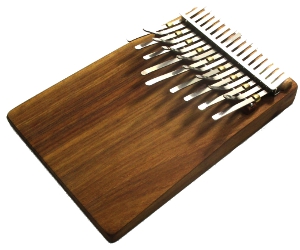
The 17-Note African Karimba can be tuned to A African, A Western (major), A minor, G Western (major), or G minor.
  African A tuning
  A Western tuning
  A minor tuning
  A minor, no buzzers
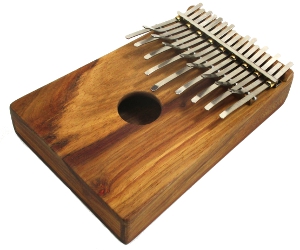
The 17-Note Box Karimba can be tuned to A African, A Western (major), A minor, G Western (major), or G minor.
17-Note Box Karimba in A minor tuning
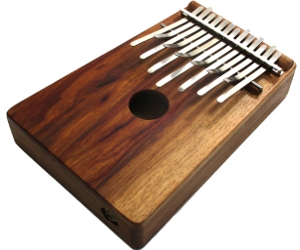
The 15-Note Karimba can be tuned to F or F#.
  F-15 Karimba
  F sharp -15 Karimba
 This is a high end karimba, or mbira nyunga nyunga, with a very low-noise pickup and adjustable “graphical buzzilizers” – plastic rings on the tines that limit the buzzer’s maximum motion, and by moving the plastic in or out, you can decrease or increase the level of buzzing. The wood, tines and everything about these karimbas are really nice. Like no other karimba you have played.
This is a high end karimba, or mbira nyunga nyunga, with a very low-noise pickup and adjustable “graphical buzzilizers” – plastic rings on the tines that limit the buzzer’s maximum motion, and by moving the plastic in or out, you can decrease or increase the level of buzzing. The wood, tines and everything about these karimbas are really nice. Like no other karimba you have played.
  Bellinger Karimba, acoustic
  Bellinger Karimba, electric
The Roots Production Kazula is a 15-Note Karimba or nyunga nyunga, and can be tuned to F or F#.
  F-15 Tuning
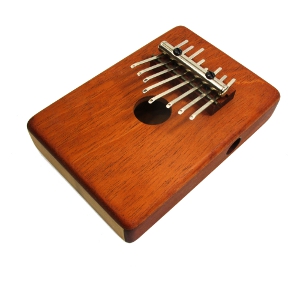
The 8-Note Goshen Box Student Karimba can be tuned to C, A, or G.
  C tuning
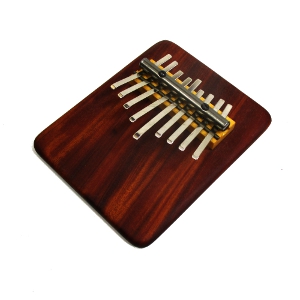
The 9-Note Goshen Student Karimba can be tuned to C, A, or G.
  G tuning
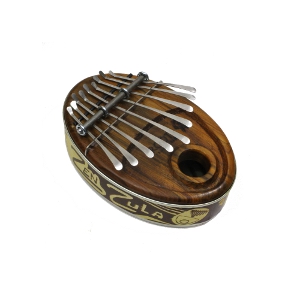
The 9-Note Zensula Mini-9 can be tuned as a student karimba in Bb or C, as well as to other unrelated tunings.
  Bb Student Karimba


Sign up for our newsletter and free resources with your email address:
We pinky promise not to spam you and to only send good stuff.
 Seek to Infuse Your Musical Moments With Beauty and Magic
Seek to Infuse Your Musical Moments With Beauty and Magic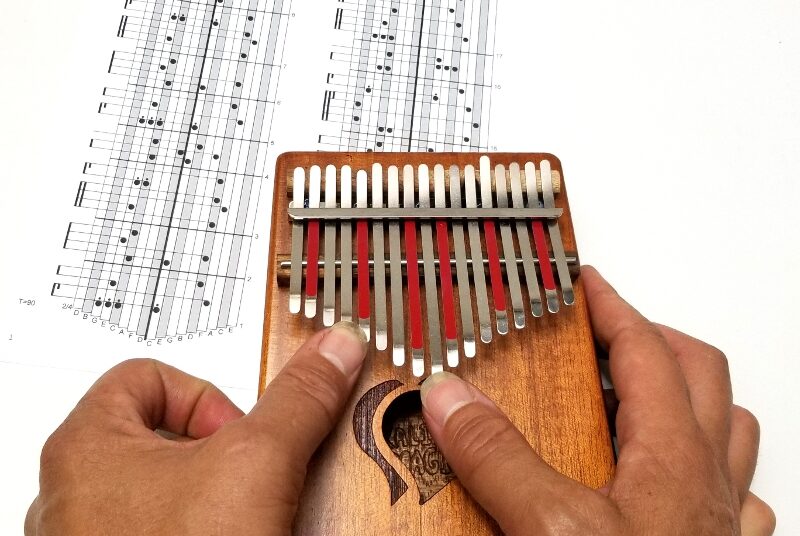 Kalimba Magic – We Give You The Tools You Need to Succeed
Kalimba Magic – We Give You The Tools You Need to Succeed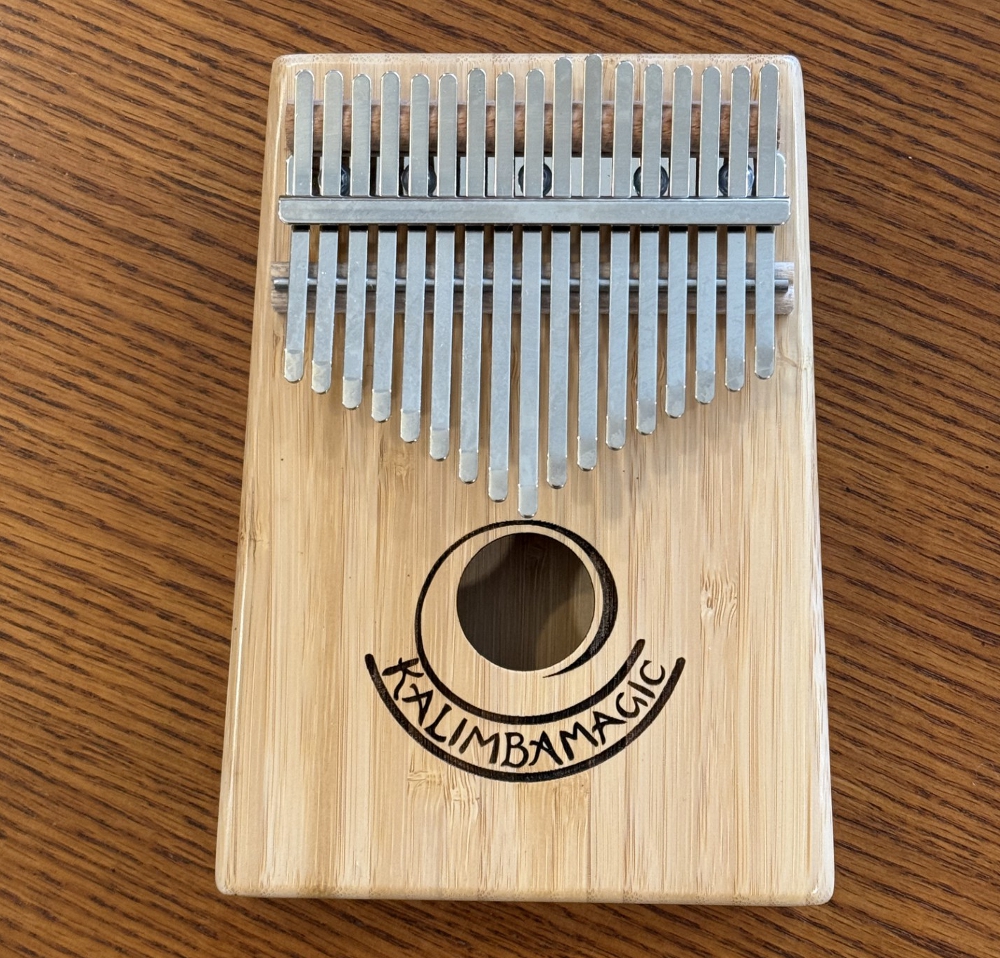 Back in Stock! The Bamboo-17 Kalimba
Back in Stock! The Bamboo-17 KalimbaUse of this website constitutes acceptance of the Privacy Policy and User Agreement. Copyright © 2020 Kalimba Magic. All Rights Reserved.